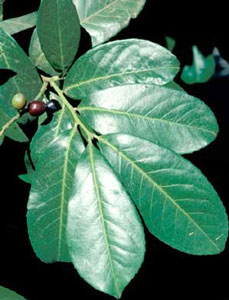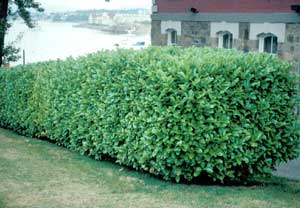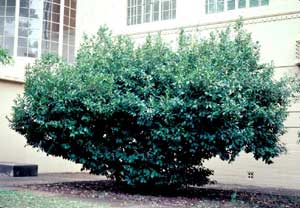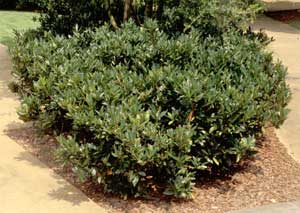Landscape Shrubs
Common Cherrylaurel; English Laurel
(Prunus laurocerasus)
Common cherrylaurel (Prunus laurocerasus) fills lots of niches in our gardens. If you consider the range from the species to its multitude of cultivars, a gardener can chose from a massive, almost tree-like shrub down to a low, spreading plant that would qualify as a medium height groundcover.
Any cherrylaurel is worth your attention. This is an outstanding group of broadleaf evergreen shrubs. Unless you are landscaping a large commercial property or you have lots of room to play with, gardeners should avoid picking the straight species. The species can reach 20’ tall with a width of at least 25’ wide. The national champion is supposed to be 32’ tall by 52’ wide!
This plant has lots of cultivars—one reference lists 26 different cultivars. You can group the commercial varieties into two categories: narrow-leaved, spreading plants and upright forms useful for hedges or screens. Cultivars in the narrow-leaved, spreading plant habit category include ‘Otto Luyken,’ ‘Schipkaensis,’ and ‘Zabeliana.’ It is likely that many of these are slightly confused in the trade, even though they are technically different. In general, these three have fairly narrow leaves and typically have a low, spreading growth habit. Leaves on these cultivars may be as narrow as 1”, in comparison to leaves on the species, which are four times that. ‘Majestic Jade’ is a nice selection for a screen/hedge plant since it has a tight conical habit like a holly.
A five-inch-long raceme of cream-white flowers is born in April. Gardeners would likely not place this in the showy category, but there are times when the flower display makes a significant contribution to the garden. The plant may bloom again in the fall. The flower is followed by a purple-black, 1/3” “berry” (called a drupe) that often goes unnoticed.
The evergreen foliage, which is dark green and glossy, is generally very clean looking. There is one problem that is so common that it may be used to help identify the plant. This is a confusing plant problem. While the leaves have a shot-hole pattern that looks like an insect was the cause, the causal agent is actually a bacterial disease. Bacterial leaf spot or bacterial shot hole is caused by Xanthomonas pruni. Initial signs of the disease are small, brown lesions that appear on the underside of the leaves in early summer. The lesions continue to increase in size until small, circular holes develop. Chemical control is difficult for homeowners, so you may have to live with this aesthetic problem. Unlike other Prunus, cherrylaurel really has few problems. Besides the aforementioned shot-hole, the other concern would be location. Like many other broadleaf evergreens gardeners should avoid heavy, compacted soils with poor drainage.
Cherrylaurel appears to thrive in both full sun and fairly dense shade. Some may raise a concern over cold hardiness, but all cultivars should do fine across Arkansas. ‘Schipkaensis’ is reported to be the most cold hardy selection.
The University of Arkansas plant evaluation program is trialing a cousin of cherrylaurel called Portuguese laurel (Prunus lusitanica) as a hedge/screen option. So far the results are not very encouraging.
If you are looking for another broadleaf evergreen for your foundation bed or a plant to mass as a medium-sized filler, you might want to give common cherrylaurel a look.
- Common Name: common cherrylaurel, English laurel
- Varieties to look for: ‘Otto Luyken,’ ‘Schipkaensis,’ ‘Zabeliana’
- Flower Color: cream
- Blooming period: April
- Perennial or annual: woody shrub
- Size: depends on cultivar
- Exposure: full sun to partial shade
- Soil: rich, organic matter preferred
- Watering: demands constant moisture during summer
- When to prune: spring or fall
- Suggested use: massed, foundation
Leaf structure and fruit

Hedge form

Form

'Otto Luyken' form
